


























Illustration by Jasmine Lee Los Angeles County’s notable buildings and skyscrapers include the Walter Pyramid, Long Beach Water Tower, Long Beach City Hall, Capitol Records and Trust Building.




























Illustration by Jasmine Lee Los Angeles County’s notable buildings and skyscrapers include the Walter Pyramid, Long Beach Water Tower, Long Beach City Hall, Capitol Records and Trust Building.
1250 Bellflower Blvd., LA4-203 Long Beach, CA, 90804
Editorial Office Phone (562) 985-8000 Business Office Phone (562) 985-1740
Christal Gaines-Emory Editor in Chief
eic@daily49er.com
Kristina Agresta Business Manager business@daily49er.com
Leila Nunez Multimedia Managing Editor multimedia@daily49er.com
Kristina Agresta Managing Editor
managing@daily49er.com
Inthis issue of the Daily Forty-Niner, our stories are united under one overarching theme: intercultural representation. The articles contributed highlight a wide range of the cultures present in Long Beach as well as Long Beach State such as the Asian American Pacific Islander (AAPI) community, the Native American community and the Black community.
As journalists, it is our responsibility to share the stories of our community and adequately represent each culture, belief, identity, perspective and more in the stories we write. Therefore, in this edition, our main goal was to shed light on these cultures and share their stories in an intersectional, accessible and respectful manner.
A few of our stories include an opinion piece about being mixed race, a news piece about representation within the House of Representatives and an arts story about the influence of Black culture in music.
At the Daily Forty-Niner, representation in our reporting as well as in the newsroom is extremely important to us and we are dedicated to continue encouraging inclusivity in the stories we produce and the work we do.
It is my hope that sharing these stories will help to educate the students and faculty of CSULB about the beauty of different cultures as well as the experiences faced within those different from your own.
That being said, there are many more articles about intercultural representation that we would like to highlight as the semester goes on. Students interested in pitching a story about intercultural representation can email me directly at eic@daily49er.com and we can further discuss these ideas. Your ideas are welcomed and your voice deserves to be heard.
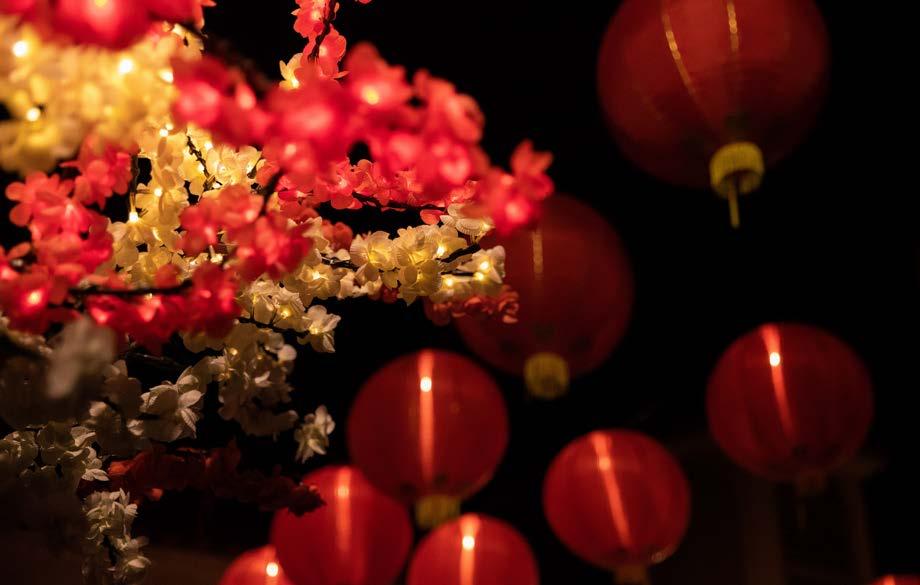
Please enjoy the Intercultural special issue of the Daily Forty-Niner! For daily news content, visit our website, subscribe to our newsletter, or follow us on Instagram, Twitter, and Facebook @daily49er.
Here at the 49er we acknowledge that the school we report on is located on the sacred site of Puvungna, “the gathering place”. We are on the land of the Tongva/Gabrieleño and the Acjachemen/Juaneño Nations who have lived and continue to live here.
We also acknowledge the Gabrieleño/Tongva (pronounced: GABRIEL-EN-YO/TONG – VAH) and Acjachamen/Juaneño (pronounced: AH-HACH-AH-MEN/JUAN-EN-YO) as the traditional custodians of the Los Angeles region along with the Chumash (pronounced: CHOO-MOSH) to the north and west, and the Tataviam (pronounced: TAH-TAH-VEE-YUM) and Cahuilla (pronounced: KAH-WEE-YAH) Nations to the east. We respect and value the many ways the Tongva/Acjachemen cultural heritage and beliefs continue to have significance to the living people and remind us about the sacred and spiritual relationship that has always existed here at what we now call California State University Long Beach.
Hannah Shields News Editor news@daily49er.com
Kadie Gurley Arts & Life Editor arts@daily49er.com
Georgie Smith Opinions Editor opinions@daily49er.com
Matthew Gomez Sports Editor sports@daily49er.com
Gisele Robinett Creative Director design@daily49er.com
Rosaura Montes Chief Copy Editor
Sam Farfan Special Projects Editor
Photo Editor
Social Media Editor
Podcast Editor
Renzo Pocasangre
Maureen Linzaga
Luke Wines Video Editor
Isabel Silagy
Kaitlyn Rowell Public Relations Editor
Community Engagement Editor
Editors AssistAnts
Richie Rodriguez
News Assistants Vincent Medina
Jaylen Minnich
Arts Assistants Stacey Chen
Opinions Assistant El Nicklin
Sports Assistants
Nicholas Broadhead
Jasmine Lee Graphic Design Assistants
Photo Assistants
Emmanuel Barrera Armando Jacobo
Kimberly Estrada
Sonny Tapia
Social Media Assistants Ani Gutierrez
Montse Palmerin
Video Assistant Tatiahna Bentley
Andy Nguyen Podcast Assistant Leila Nunez Web & Technology Manager
BusinEss
Purva Rao Advertising Manager advertising@daily49er.com
Jasmine Lee Creative Director
creative@daily49er.com
web@daily49er.com
Kaitlyn Rowell PR & Promotions Manager
PR@daily49er.com
Jesse Kalamian Distribution Manager
Copy Editor Assistants Jazmin Gallardo distribution@daily49er.com
Jacob Mitchell Distribution Analyst distribution@daily49er.com
AdvisErs
Gary Metzker Design Adviser
Barbara Kinglsey-Wilson Content Adviser Jennifer Newton Advertising & Business Adviser
Letters Policy: All letters and emails must bear the phone number of the writer and must be no more than 300 words. The Daily Forty-Niner reserves the right to edit letters for publication in regard to space.
Editorials: All opinions expressed in the columns, letters and cartoons in the issue are those of the writers or artists. The opinons of the Daily Forty-Niner are expressed only in unsigned editorials and do not necessarily reflect the opinions of the journalism department or the views of all staff members. All such editorials are written by the editorial board of the Daily Forty-Niner.
After taking a hiatus from the unprecedented effects of COVID-19, The Annual CSULB Pow Wow is finally making its return this spring semester.
American Indian Studies Director Craig Stone discussed the impact and hardships of COVID-19 on the American Indian community.
“When an elder dies, it’s like losing a library,” said Stone. “The life expectancy for American Indians dropped to 65 years of age.”
The impact of COVID-19 heavily affected the American Indian community, as with many other disenfranchised communities. American Indians in the Los Angeles County area had the help of Patricia Lopez and Dr. Norma Blackwater of United Native American Indian Involvement, commonly referred as the UAII, to outreach and administer vaccinations.
Stone says the legacy created through the American Indian Student Council and American Indian counselors formed a lasting support system to this day, through which Native American Indian values have
survived and helped the community.
CSULB’s Pow Wow is historically the oldest Pow Wow in the Los Angeles-Orange County area and the CSU system as said by Stone. CSULB is historically built upon the Native lands known as Puvungna, a sacred site for American Indians local to the Los Angeles-Orange County area.
Puvungna once housed an American Indian village and American Indian burial sites, but were swiftly disrupted through multiple development projects for portions of the Cal State Long Beach campus.
The CSULB Pow Wow remains as a significant celebration of life for the lo-
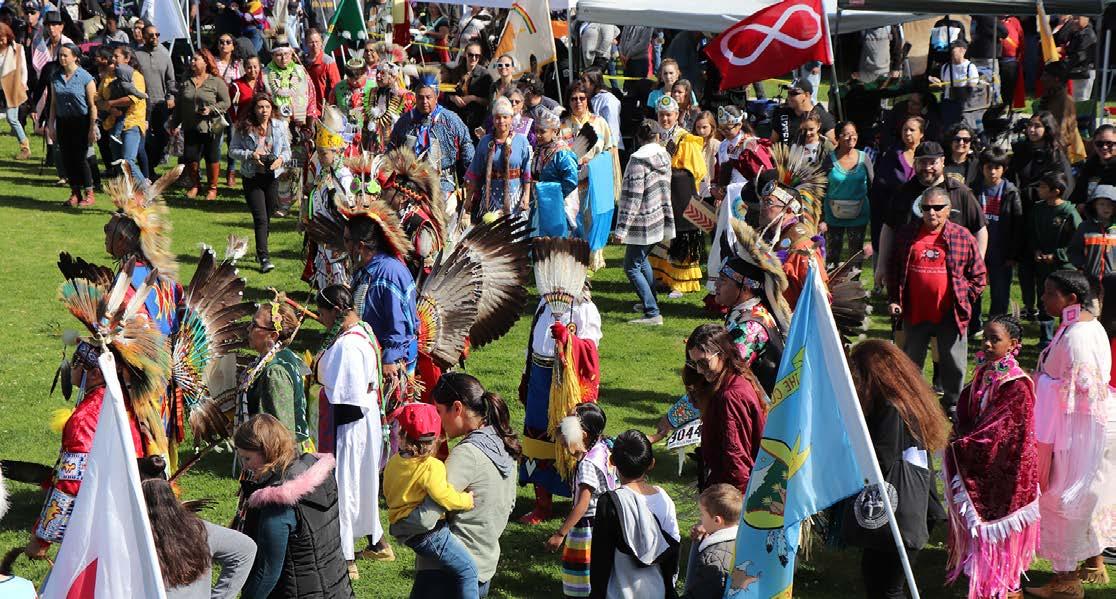
cal Tongva community and other Indian Americans in Southern California, as well as for non-Indian American community members.
Stone expresses the significance of the 50 year anniversary and its three long years of planning and development, despite hardships.
“We’re one of the last Pow Wows to come back now,” said Stone. “The second weekend in March has been our weekend for a long time.”
Incoming president of the American Indian Student Council Eleanor Nelson is excited and anticipated for this year’s re-
turn of the CSULB Pow Wow.
“I can’t wait to see my community again, I can’t wait to see other people who aren’t even American Indian to experience our culture,” said Nelson.
“It’s really huge in understanding our culture, our people and our necessities in our community.”
The American Indian Student Council will be hosting and co-sponsoring the 50 year anniversary celebration of the CSULB Pow Wow. The American Indian social celebration is slated for March 11 and 12. It’s set to take place on the upper campus quad.
Around 100 million Americans cast their ballots in the November 2022 midterm elections, voting in 435 House of Representative races, and elected the most diverse Congress in the history of the United States.
In the Senate, Markwayne Mullin (R-Oklah.) of the Cherokee Nation became the first Native American senator to serve in over two decades. Meanwhile, in the House, the election of Rep. Maxwell Frost, who is both Black and Hispanic, marked the first accession of Generation Z to national politics.
Despite this recent growth in diversity, the makeup of Congress remains unrepresentative of the broader population, according to the Pew Research Center. The more democratic chamber, the House, is 70% non-Hispanic white, while in the Senate 88 of 100 members also identify as such.
The common assumption is that the outcomes of races are decided by the voters, through the election process.
All else held equal, in this theory the House of Representatives would be 60% non-Hispanic white, while the more dominant white majority in the Senate would drop from 88 to 59.
This theoretical world is not reality; functioning as the Constitution intends, the will of the voters is only a single non-dominating variable in the final outcome of
democracy. It is these other variables that lead to a discrepancy, often tied to race, ethnicity, gender and socio-economic factors, in who our representatives actually represent.
In the case of the Senate, the demographic inconsistency originates from the chamber’s equal representation by state.
California contains over 15 million residents who identify as Hispanic; Wyoming, a state with a total population of 579,000 is privy to the same representation in the Senate. This system is intentional in design, with the express purpose of limiting
the power of larger states on a federal level.
The situation in the House of Representatives is far more multifaceted, involving a multitude of bipartisan government agencies and political entities.

Every 10 years the United States federal government embarks on the monumental task of counting every single individual living in the United States. The results of these censuses serve as the framework for our elections, aiding state governments as they draft their congressional districts.
Once finalized and handed to the state legislatures, this data is used to slice up the
country into congressional districts, each representing an average of 710,000 individuals.
The ability to shape these borders is an incredibly powerful tool that can be used to favor political interests by either packing opposing groups into a single district or cracking their communities in an attempt to dilute their votes; these two actions are collectively referred to as gerrymandering. As such, the process governing how these lines are drawn is complicated and subject to intense political debate.
Over the decades the Supreme Court has ruled on hundreds of gerrymandering cases, but despite this, the Court has yet to take a definitive stance on the constitutional standards by which congressional districts should be judged.
This has allowed both major political parties to crack and pack various groups, from racial to partisan, as long as they tow a line of plausible and acceptable deniability. The result is a country that disproportionately over-represents non-Hispanic whites in the House of Representatives.
The United States is subject to the oldest functioning Constitution in the world, one which is adverse to change by design. The existence of two arms of Congress, one with equal representation among the states, is an almost uniquely American system, as is the process of gerrymandering.
Supporters of the existing system argue for its longevity and stability, while those opposed to its continuation point to other, more democratic, western democracies as evidence for improvement.
Photo Editor ART NERI / American Indian Studies Administrative Support Coordinator Dancers and visitors during the round dance of CSULB’s 2019 Pow Wow. Courtesy of Wikimedia CommonsKrupaly Patel, a senior majoring in molecular cell in biology and physiology, had her whole life change when she read a school-wide email about the university’s support for DREAMER students.

Patel’s family typically paid a lawyer over $2,000 apiece for her and her brother to renew their DACA status, until she learned about the Dream Success Center through email. She was able to get the fee covered.
The DSC has resources available on campus for students like Patel who are undocumented.
“We saved so much money from that and I know a lot of undocumented people struggle with financial issues,” Patel said.
The center serves students from different countries all over the world.
“I hope that students feel comfortable coming into our space and asking for support,” said Norma Salcedo, the first fulltime DSC director since June 2020.
“We’re here to help students in any way that we can and hopefully [they can] see our friendly faces,” she continued.

Undocumented students and students with tuition exemptions under California Assembly Bill AB540 can receive resources and services at DSC for free. The Butterfly Peer Mentor Program, developed at the DSC in fall 2020, hires CSULB student mentors to support undocumented students in their on-campus experience.
 BY ROSAURA MONTES AND RENZO POCASANGRE Chief Copy Editor and Photo Editor
BY ROSAURA MONTES AND RENZO POCASANGRE Chief Copy Editor and Photo Editor
“It was very powerful for us to have that peer-to-peer support,” said Salcedo. “And we’ve seen how many mentees over the years have returned as mentors.”
The immigration legal services available at DSC are free for CSULB students, staff, faculty and their families regardless of immigration status. Alumni who graduated within the past two years can also receive support. Services are available via appointment.







One of the DSC student assistants is International student Lucah Medina Guerra from Mexico City, Mexico, a senior majoring in Molecular Cell Biology. Cal State Long Beach has allowed Medina to
prepare for the medical field while working at the Dream Success Center.
“Because I’m an International student, I can only work on campus, so definitely for my first semester I was trying to find a job,” said Medina.
Medina said that he hopes to let more students know about DSC and the employment opportunities for students.
Since learning about the DSC and being part of their Dream Success Incentive Program, Patel doesn’t feel alone.
“People are just very supportive here,” she said. “Whether you’re talking [to] people at the front desk, the director, they always have answers for you.”
Keck Graduate Institute (KGI) in Claremont, CA, offers innovative postgraduate degrees and certificates that integrate life and health sciences, pharmacy, genetics, engineering, medicine, and business with a focus on industry projects, internships, and team collaborations. KGI’s welcoming, diverse environment allows students to think creatively and critically, communicate and interact effectively, and act ethically and respectfully.
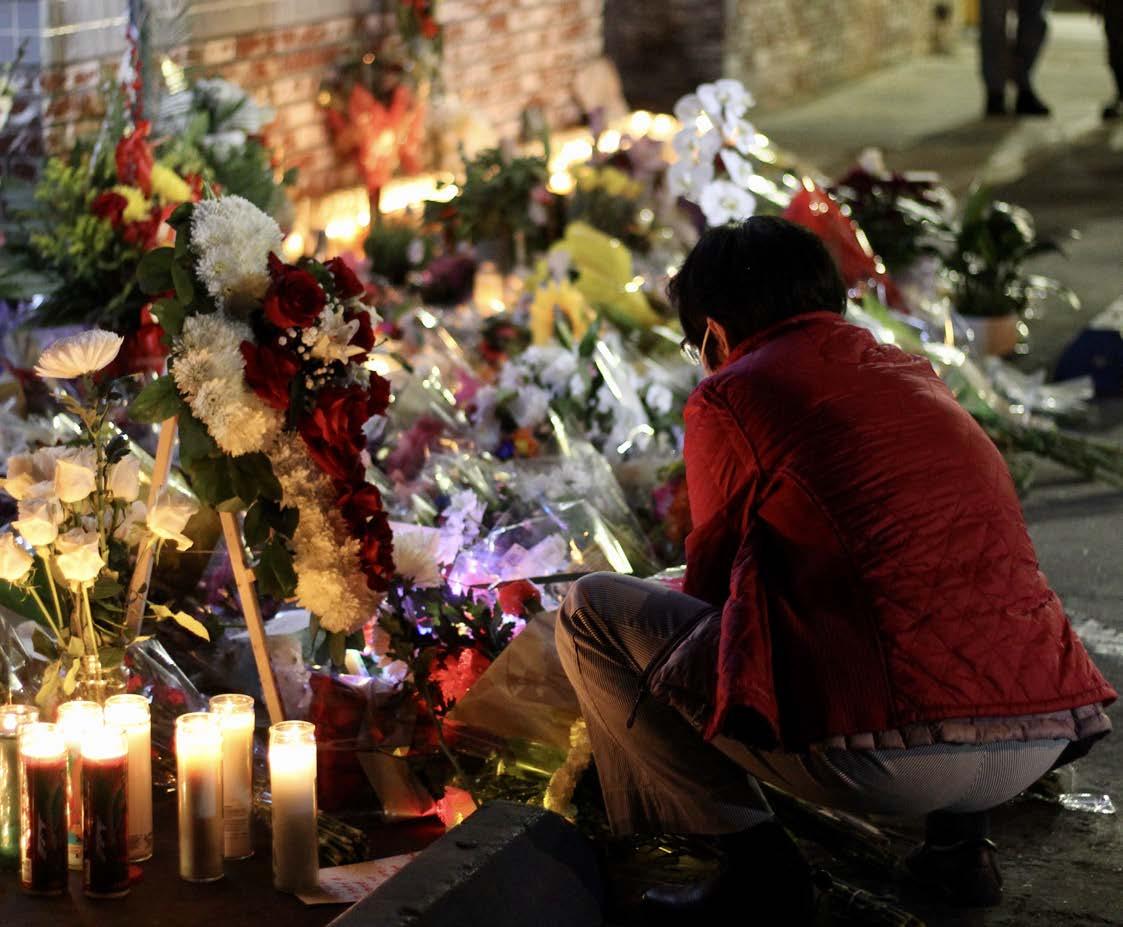 BY HANNAH SHIELDS News Editor
BY HANNAH SHIELDS News Editor
hen Elnora Phu woke up Sunday morning, Jan. 22, her phone was buzzing with texts and missed calls from friends who were out of town, asking if she was safe and whether she was okay.
When Phu opened up her Instagram account, her social media feed was flooded with posts and headlines talking about a mass shooting in Monterey Park that happened the night before, a city which was just a ten-minute drive from where she lived in Rosemead, CA, in the San Gabriel Valley.
“I couldn’t believe that I saw ‘Monterey Park’ and ‘mass shooting’ in the headlines,” Phu said. “I couldn’t process it.”
The night before, which was the first day of a two-day celebration ringing in the Lunar New Year, a major holiday in the Asian community, Phu had dinner with her cousins before going to bed around midnight.
Her family had plans to visit a few temples later on Sunday, but Phu chose to stay home, saying she didn’t feel safe enough to go out into her community, especially when, at the time, the shooter suspect was still at large.
“When I think about Monterey Park, I think about the community,” Phu said. “I feel so safe walking around there at night.”
The San Gabriel Valley native said, for once, she felt anxiety about going out into her own community and closely followed the news as SWAT cornered a white cargo van in Torrance, where the later confirmed shooter suspect died of a self-inflicted gunshot wound.
The mass shooting in Monterey Park, the deadliest in LA County history, had left 11 victims dead, nine wounded and entire communities reeling from the tragic event.
Phu is a senior grad student at Long Beach State University, about to graduate this spring with her master’s degree and complete her social work program. Her goal is to become a licensed clinical social worker and work with people of color.
“As a social worker/therapist, I am
expected to hold space for my clients, but I realized that I haven’t had the time to hold space for myself,” she said. “These past couple of days have been emotionally draining and while I’m in class or internship, it’s been hard to focus when all I can think about are the victims and their families.”
Phu is the secretary for the AAPI Social Work Student Network at CSULB, a
tive statement that was being organized by their department.
Faculty and staff from various Asian American and Pacific Islander communities at CSULB, where Asian students make up around 20% of the student body, wrote a collective statement in regard of Saturday night’s devastating event.
“We are heartbroken at yet another traumatic gun violence in the U.S. that
and another on Tuesday night, at Star Ballroom Dance Studio, where the shooting took place.
“While I was at the vigil tonight, I feared for my safety and have been more aware of my surroundings,” Phu said.
Kevin Leung, from Siu Lum Pai Kung Fu Association Monterey Park, is a colleague of Phu’s who is also a Kung Fu instructor at Star Ballroom Dance Studio. Leung teaches self-defense classes in partnership with a non-profit program, Compassion in SGV, which Phu also volunteers for.
Compassion in SGV was started during the rise of anti-Asian hate crimes around the time of the pandemic. This organization, Phu said, offers chaperone services as well as self-defense training classes, all in effort to better support the AAPI community.
“I’m hopeful, but I’m kind of fed up with the system,” Phu said, in regard of the Asian community having to overcome yet another attack, despite whether or not it was racially motivated. “I know a lot of people use the word ‘resilience’ but sometimes it’s like, how much more can we take?”
committee which acts as a support group for students from the AAPI community. The organization holds meetings where members can talk about their internships, classes or any current events which have affected them.
In regard of creating a special meeting for those personally affected by the Monterey Park shooting, Phu said this was something they still needed to discuss.
“As cabinet members, we haven’t had a chance to talk about that,” she said, adding they’ve been asked to contribute to a collec-
took, injured, and traumatized precious lives,” the statement read. “While many know Monterey Park as the first city in the continental U.S. with an Asian-majority population, it is also a home and place of both belonging and resistance to a multiracial, multiethnic, and multigenerational community.”
Phu attended two vigils that were held in honor of the victims of the Monterey Park shooting-- one on Monday night at Monterey Park City Hall, about a half a mile away from the site of the incident,
WANDREA LOPEZ / Daily Forty-Niner Mourners placed flowers with hand written notes during the vigil on January 24, 2023.These past couple of days have been emotionally draining and while I’m in class or internship, it’s been hard to focus when all I can think about are the victims and their families.
Elnora Phu Senior graduate student

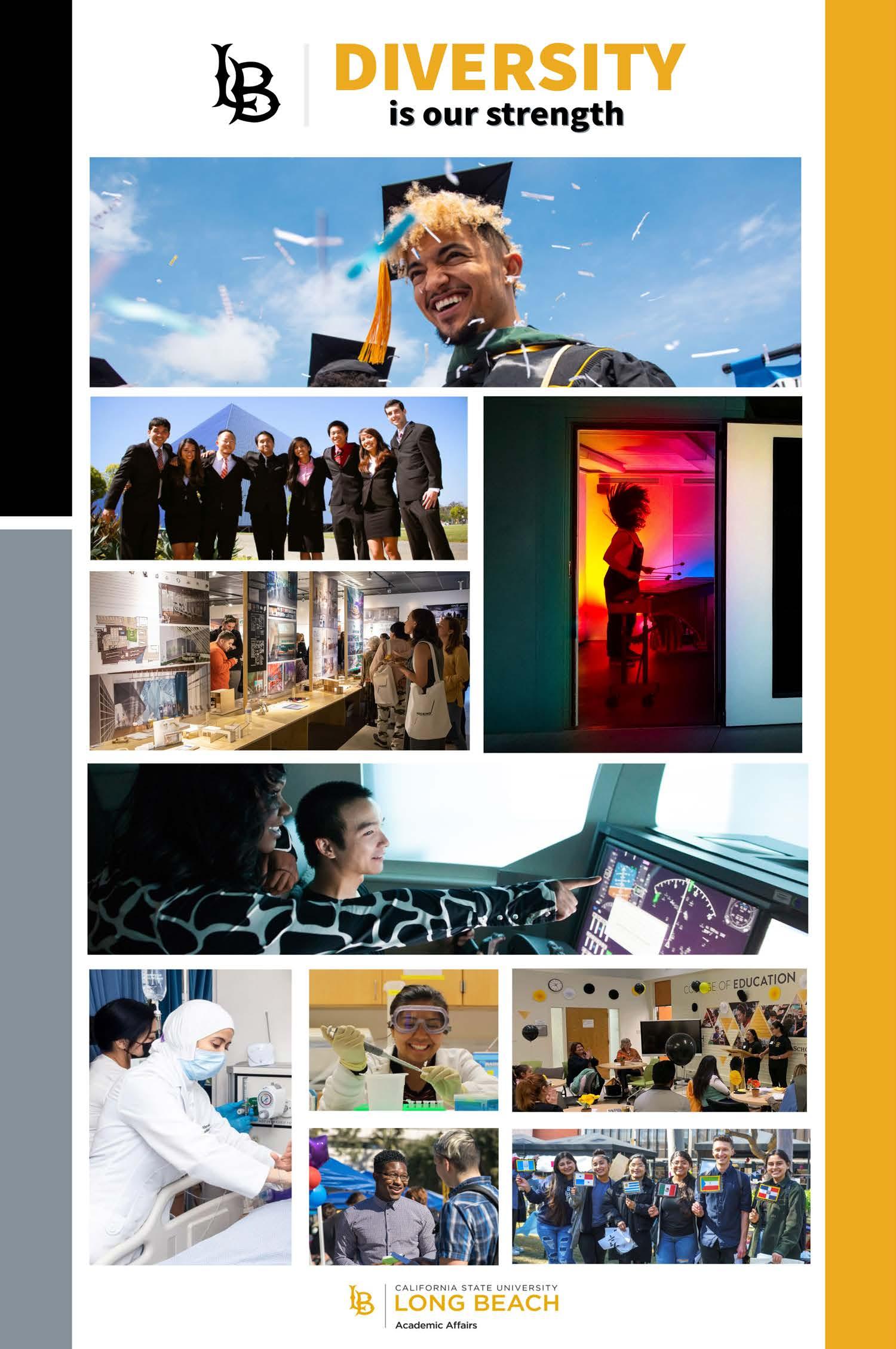
Guided by values of togetherness, tradition and prosperity, the Lunar New Year is one of the most honored holidays in Asia and around the world.
Due to the recent Half Moon Bay and Monterey Park mass shootings that disproportionately affected those of Asian descent, the aspect of solidarity in the community has resounded this year more than ever.
Long Beach State is no stranger to its cultural significance. The diverse student body, faculty and staff participate in Lunar New Year festivities both on campus and in their homes.
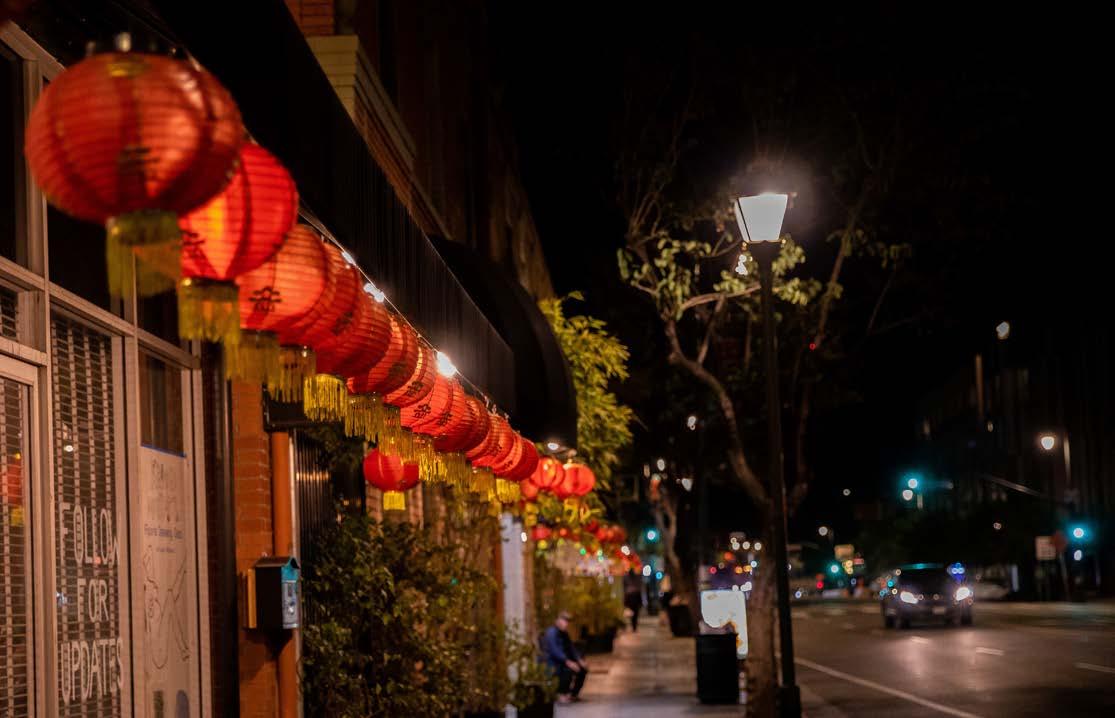
“By sharing different cultures, it helps other people connect and notice similarities, which then creates a deeper connection amongst each other,” said Lynette Lanh, a student assistant at the Earl Burns Miller Japanese Garden.
Unlike the Gregorian calendar which consistently starts on Jan. 1, the lunar calendar this year began on Jan. 22, and is celebrated for 15 days until the next full moon appears.
“There’s definitely more thought, effort and meaning behind [Lunar New Year],” said Kylie Yam, an undeclared freshman. “We clean the house before the new god comes in as well as driving away the bad luck from the previous year.”
Although commonly called the “Chinese New Year,” the lunar year is also celebrated in different ways across Asian countries including Japan, Vietnam, Indonesia, South Korea and more.
As for food, Yam mentioned the Cambodian dessert “Numkom” as a staple part of her family’s new year dinner, next to
BY KADIE GURLEY Arts & Life EditorNo matter what kind of music you listen to, there’s a high chance that its foundation is based on and influenced by Black culture.
From Elvis Presley to Bad Bunny, many of the most popular music artists of our time created, or in a few cases, covered music that was originated by Black people over the years.
Genres including rock and roll, blues, jazz, soul, funk, rap, gospel, reggae and spiritual are just some styles of music that originated and were cultivated by African Americans.

Black Americans’ impact on music runs deep when the history of slavery at its core is taken into account. Many sought out music as a way to step away from the shackles and burdens of the torture they faced during those times.
Forcibly coming to the United States from Africa, spoken word and singing spirituals served as a prayer to unite the African tribes. These were the type of religious folksongs that are most closely associated with the enslavement of African people in the American South.
According to the National Park Service, singing played an important role in the quest for freedom.
Music is deeper than a genre. It digs deep into pain, triumph and culture.
“Every tone was a testimony against slavery, and a prayer to God for deliverance from
many servings of fruit, roasted chicken and duck.
Since Yam is half Mexican and half Cambodian, she had moments of insecurity regarding if she was “Hispanic or Asian enough,” but she finds that abiding with the cultural community during the holidays helps.
“I’ve always felt in touch with my Asian roots because I was raised and spend the most time with that side of my family, but
participating in Lunar New Year and TLC (Thai, Laos and Cambodian) New Year definitely reassured me,” Yam said.
A notable on-campus Lunar New Year celebration is held at the Earl Burns Miller Japanese Garden where the students and Long Beach community can experience more of the Japanese traditions.
Known as the “New Year Sekku,” it is one of the garden’s many returning cultural events after COVID.
The event facilitates community con-
nections through activities such as calligraphy tables where attendees can learn how to write in Hiragana or Katakana, opportunities to create Origami, as well as the handing out of red envelopes and goodies for students and families to take home.
“Here at the garden, everyone believes it’s important to reach out to various communities, as it is important to have social connection and a sense of belonging,” Lanh said.
chains,” Frederick Douglass once said. This influenced the birth of rhythm and blues along with jazz years later. Just like spirituals, blues included work songs, field hollers and chants and became known as folk during the 1860s. African Americans from the Deep South rhymed simple narrative ballads sharing the pain, torture, discrimination and other challenges they faced.
According to the Library of Congress, the first recording of jazz music was in 1917, “Livery Stable Blues” performed by the Original Dixieland Jazz Band, and was a best-selling record. Being the “first” was problematic as it is a recording of a white band performing an African American genre.
Ultimately, blues transformed into a new musical element called rock and roll. Many refer to singer Elvis Presley as the King of Rock, but the first pioneer of rock and roll came from singer-songwriter Chuck Berry.
Originally from St. Louis, Missouri in the 1950s, the town he resided in was segregated. Berry joined a band with one of his friends and often played jazz and pop music in Black nightclubs around St. Louis.
Many believe his song “Maybelline,” released in 1955, is the first acclaimed rock and roll hit based on its technical rhythm and blues beat, hints of country guitar, Chicago blues flair and narrative storytelling.
Other genres including soul, R&B, hiphop, reggae, reggaeton, funk, gospel, rap and more of the top-charting music today, go all the way back to Black culture.
The foundation set by Black Americans revolutionized music today and is expanding globally.
SONNY TAPIA / Daily Forty-NinerVarious music genres are influenced by Black culture in America.
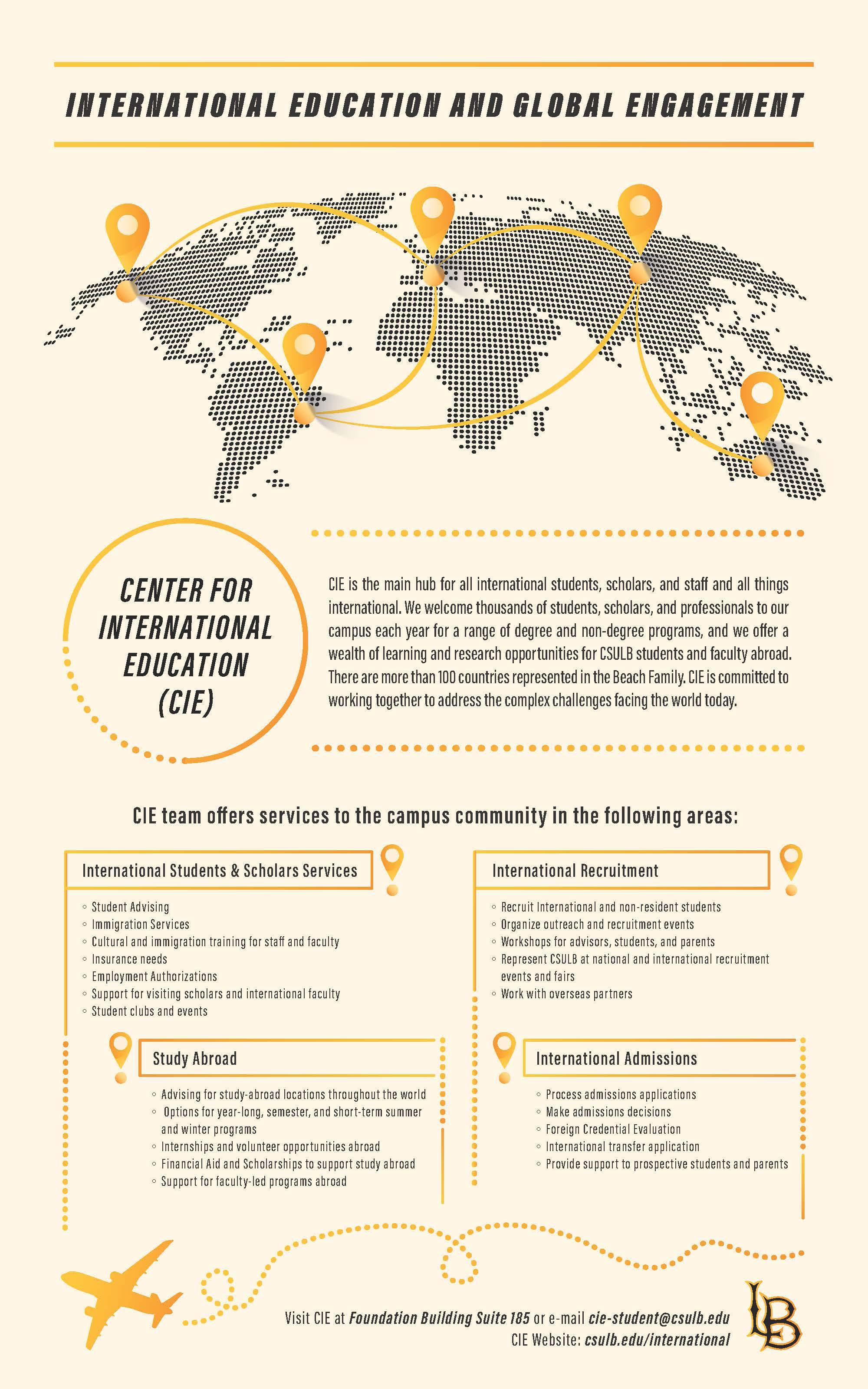
It boils down to two simple components: dough and filling.
 BY KRISTINA AGRESTA Managing Editor
BY KRISTINA AGRESTA Managing Editor
The Long Beach State campus is known for its diverse and inclusive campus, which has been a factor in the pursuit of higher education for many students.
In the Journalism and Public Relations Department alone, there are several inclusive and diverse associations for student journalists to be a part of.
National Association of Hispanic Journalists is a resource available to Latinx students in the department. Within the group, students are able to be involved in the CSULB chapter of NAHJ to gain knowledge and support from guest speakers, including
“Come as you are; you will be welcome.”
Starting as living room gatherings in 1977, The LGBTQ Center Long Beach “The Center” has become a staple resource for the city’s LGBTQ+ community. Sitting on the iconic “Retro Row,” the Center has acted as a meeting place and sanctuary for LGBTQ people.
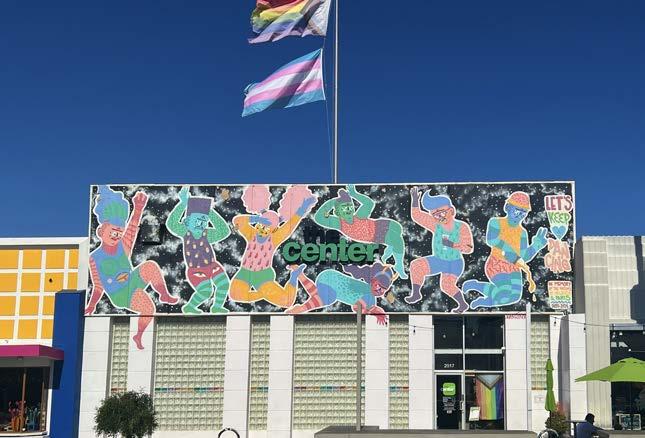
The Center has provided many services and resources for its community over the years. Most prominently in 1984 when Project Ahead, the first case management service in Southern Los Angeles County, was established to combat the AIDS epidemic. It was a safe space to “receive HIV information, testing and counseling, healthcare referrals, and other sup-
port services.”
Today the Center continues to serve its community through workshops and seminars, youth, family, and student services, a lending library, a cyber center, free HIV and STI testing, employment referrals, educational forums, mental health counseling, cultural/social activities, and even legal assistance and domestic violence services.
Carlos Torres, executive director at The LGBTQ Center, further detailed some of these services.
“We have an attorney on staff and a team of pro-Bono attorneys who help our clients with a variety
Rolling Stone magazine and ABC7 Los Angeles. A resume workshop is underway this spring for the association and its members.
Being part of the association has given Cassidy Reyna, CSULB NAHJ president, a sense of community, making sure that they never feel alone in their college journey.
“As someone who’s always struggled to find their place, my goal as president is to provide a safe space for all members to know that no journey is linear and it’s never easy,” said Reyna. “But having people who support you and are in a similar situation can make a huge difference.”
Read the full story at daily49er.com
China
India Samosa

of different topics from family law to asylum-seeking, immigration, or criminal cases,” he said. “We serve all of [LGBTQ+] California with that.”
Other services include offering families of LGBTQ students the proper information and resources needed to support students inside and outside the classroom. For older adults, there’s a focus on social isolation and food scarcity.

Read the full story at daily49er.com
Italy Ravioli


When “Everything, Everywhere, All at Once” was released in 2022, it shook audiences to their core across the world. The film touches on topics that have been underrepresented in mainstream Hollywood: namely, Asian American and LGBTQ+ experiences.
Within the intersection of these identities, EEAAO focuses on how mother-daughter relationships are affected through Evelyn and her daughter, Joy. Joy’s dark feelings of isolation and rejection span across every universe in the film. This is a literal interpretation of the turmoil that many people experience due to a lack of acceptance as they are.

Most viewers can find some connection to these characters, but the strain in their relationship especially hits home for those in the Asian American and queer communities.
As Evelyn and Joy’s relationship heals, so can the audience. By the end of EEAAO, Evelyn becomes more receptive to her daughter’s sexuality and open about her feelings, two previous points of contention in their relationship.
“Of all the places I could be, I just want to be here with you,” Evelyn says to her daughter. The film takes its viewers through a cathartic journey of queer acceptance and healing generational trauma.
BY RICHIE RODRIGUEZ Community Engagement EditorWhat do Bad Bunny, BLACKPINK, Frank Ocean and Rosalìa all have in common? Well apart from being some of the big names in music entertainment right now, they’ll all be headlining and performing at this year’s Coachella Festival.
But there is more that goes on behind the scenes outside of the Instagram posts and flashy outfits.
Despite the hot and long days in the desert, the festival continues to attract the likes of influencers, vendors and artists.
The two-weekend event hasn’t improved the lives of the Latinx community who are the backbone of the region and keep the farm labor work going the other 50 weeks through the year.
Even as the contrasts and the comparisons are something that occur yearly, there are signs that rather than getting better, they are getting darker. Many of the workers who go to the Coachella Valley to work for the summer season picking grapes reside in poverty-stricken living conditions and trailers.
In 2019 farm workers in the area were picking up late shifts cleaning up trash for $11/hr after the festival, even after working in harsh temperatures. Coachella hasn’t posted its revenue since 2017 but in those two weekends, the festival grossed
EEAAO doesn’t just focus on Evelyn’s relationship with her daughter, but also the roots of Evelyn’s struggle. As an Asian American immigrant, Evelyn has a unique perspective. She resents her life because it feels like a series of bad decisions and lost potential, and ends up projecting these frustrations onto her daughter and husband, Waymond.
Through multiverse travel, Evelyn explores all of the ways her life could have gone, and she gains a new appreciation for her current life and family. It’s the little things.
“In another life, I would have really liked just doing laundry and taxes with you,” Waymond tells Evelyn.
“Everything, Everywhere All at Once” touches on Asian American and queer identity in a way that is both sensitive and realistic.
One example of its sensitivity toward LGBTQ+ experiences is the moment when Evelyn introduces Joy’s girlfriend to Joy’s grandfather. Evelyn chooses to refer to Joy’s girlfriend as Joy’s “very good friend,” dismissing her daughter’s sexuality. This same scene also portrays family dynamics in Asian culture, where younger family members will shield elders from difficult news, even at the expense of authenticity.
The intercultural narratives in “Everything, Everywhere, All at Once” are vital to its success. The film has been nominated for 11 Academy Awards and any wins will be well-deserved.
Whether or not EEAAO wins Best Picture at the Oscars, it is the most culturally impactful film of 2022 and will continue to resonate with those who see themselves in it.
“There are people who felt something
in this character. People who are rooting for roles like this to exist, people who are rooting, also, for me to elbow more space or even just to stand here,” said Stephanie Hsu, who plays Joy, to Entertainment Tonight.
around $114.6 million according to statista.com.
Brianna Finnell grew up in La Quinta and lived there until 2015 and added that the festival would have its benefits like creating revenue for the hotels, restaurants and retail stores. Though she also added it had its drawbacks with the influx of festival goers.
“I do think that not enough money is going back to that community or dispersed other places rather than the tourism spots,” Finnell said. “The further you go east, the worst the neighborhoods get”
For many years, clean water was also a luxury that many farmworkers who live in the Eastern Coachella Valley didn’t have access to.
In March 2022, the Environmental Protection Agency cited that four mobile home park water systems in Thermal, CA presented dangers to residents with high levels of arsenic present in the tap water.
The Coachella festival organizers and attendees can’t be bothered to see beyond the $1,200 ticket, Snapchat filters or likes on their Instagram posts. There is also no obligation for the artists or performers to reshape the inequitable economy in the Coachella Valley as they make millions in ticket sales and merch.
Though looking just beyond the main stage and in the horizon are the exploited farmworkers. A contrast between a surreal fantasy and a dark reality.
 EL NICKLIN / Daily Forty-Niner Everything, Everywhere All at Once has been nominated for 11 Oscars, including Best Picture.
Courtesy of Palm Springs Life
The contrast of those attending the Coachella weekend and the farmworkers who keep the region running.
EL NICKLIN / Daily Forty-Niner Everything, Everywhere All at Once has been nominated for 11 Oscars, including Best Picture.
Courtesy of Palm Springs Life
The contrast of those attending the Coachella weekend and the farmworkers who keep the region running.
Growing up as predominantly white while mixed race has made me realize that I have buried another half of me.
BY NICHOLAS BROADHEAD Sports AssistantWhenever I fill out an application where I’m asked to put down my race, my parents always said to label myself as white.
They aren’t wrong. My dad is Italian-American and both of his parents were born in the United States.
But the thing is, my mom is Mexican.
She was born and raised in Zacatecas, then moved to the United States in the 1980s for a chance at a better life. There is a part of me that denies that history and culture every time I check off that white options box.
As a child, I was raised in a community that was predominantly white and visited my grandparents in Sacramento, focusing more on American culture and
values.
From this, however, I never learned Spanish nor did I really connect with my family that lived in Mexico. Although I visited when I was 6 years old, I remembered always having to rely on my mom for translation.

There are still moments of missing out and relying on others to this day. Having to grab coworkers at my retail job to help out guests who only speak Spanish. Missing out on conversations coworkers have with each other in Spanish makes me feel alone and so out of place.
That lack of connection sometimes makes me feel like I’m a fraud in my identity.
I should know the language. I should
understand my culture and history. I should experience a world that is different from the one I’m familiar with.
There was some integration between both cultures, as Mexican food has always been a part of family meals. But that is so small compared to what I should know.
Why put so much pressure on myself? Shouldn’t I just be happy with my current lifestyle?
Being multiracial is a gift. It means being able to have more experiences in different cultures, opening the door to opportunities both in my personal life and my profession. Something that does help me through these emotions is knowing that there are others that are probably in the same situation.
According to the 2020 United States Census Bureau, just over 10% of Americans are multiracial, with 19.2 million of them being white and some other race.
My childhood was enjoyable and I wouldn’t trade it for the world, but I wish I could have had more growth. There is still time for me to embrace this other half. I still have the ability to grow and learn so many things about my Mexican culture and myself.
It’s already started at my job. Many of my coworkers have taught me more about my roots, from things like holiday traditions to phrases and sentences.
Although this feeling may linger within me as I try to grow, I know that this work will help lead me to my true self.

R’Bonney Gabriel is the first Filipino-American to represent Miss USA in the Miss Universe competition and win the title, which given her Filipino heritage, is a big deal.

Pageant culture is very prevalent within Filipino culture and it is something that the country takes great pride in. In this year’s Miss Universe competition, the Philippines saw an end to their decade-long streak of advancing into the semifinals, which their representative, Celeste Cortesi, received much criticism over.
In this year’s competition alone we saw three women represent the Philippines: Cortesi (Philippines), Gabriel (USA) and Alicia Faubel (Spain). Gabriel and Faubel, although not representing the country directly, still proudly displayed and talked about their love and pride in being Filipino.
“Tap into what makes you unique and fully embrace that,” said Gabriel in an interview with CNN Philippines. “As the first Filipina-American Miss USA, I
embraced that whole-heartedly. I think that is what makes me strong and I would encourage girls to really look into what makes them unique and what makes them special, and not compare themselves to anyone else.”
When homeland Pinoys criticize
Cortesi or overlook the milestone that is Gabriel’s win, it perpetuates the double standard we hold in our culture of not being Filipino enough when you are Fil-Am.
I was reading discourse on social media the night of the competition, particularly TikTok, and the main point
of discourse surrounded Gabriel’s win and Cortesi not even placing in the top 15 in the semifinals. With the commentary boiling down to “she didn’t deserve to win” and “she will go down as the one who ended the streak.”
How unhealthy is that?
The pressure we have put on these women is astounding. Especially once we take into consideration that they both have honorably represented their heritage with grace and pride.
“To represent my country, the Philippines, is my greatest honor,” said Cortesi.
My hope is that we can look back at Miss Universe 2023 as Filipinos from all over the world and simply acknowledge and admire the women that represented us because for so long we yearned for this type of representation. I hope that we can grow to appreciate those who take pride in their heritage just as much as someone who is from the mainland or have parents who happen to both be Filipino.
Panalo naman para sa kultura (It’s a win for the culture anyway).
KRISTINA AGRESTA / Daily Forty-Niner Nicholas Broadhead embraces both sides of his cultural identity. KAITLYN ROWELL / Daily Forty-Niner Miss Universe title holder, R’Bonney Gabriel during her crowning moment.Homophobia continues to take part in sports from both organizations and its communities. Even with outcry from those who support LGBTQ+ communities, these events continue to occur within the public eye.
BY NICHOLAS BROADHEAD Sports AssistantInclusiveness is an ongoing battle within the world of sports, as multiple events throughout the last year have displayed anti-LGBTQ+ sentiments to their communities.
One of the biggest to occur was the FIFA World Cup, as it was publicly known that its host country Qatar has a history of homophobic practices and laws.

According to an investigation from Human Rights Watch, there have been multiple reports of Qatari police beating and harassing of LGBTQ+ individuals because of their gender expression.
This has caused professional soccer players like Australian player Josh Cavallo, one of the only top-flight players to come out as gay, to speak out about the homophobic country.
In an interview with CNN, Cavallo says that although he wouldn’t be scared to visit the country since he is in the public eye, he worries about the wellbeing of those who visit and or even live in countries like Qatar.

Even though these physical dangers are less likely to occur within the United States, some individuals do share anti-LGBTQ+ sentiments.
Professional hockey player Ivan Provorov didn’t take part in last Tuesday’s Pride Night for the team. While other players from the Philadelphia Flyers were wearing Pride jerseys during their warm up, Provorov refused to wear one, citing his religious beliefs as reason to not participate.
While Provorov claimed that he respects everyone and their choices, many individuals, including Senior NHL Columnist Pierre LeBrun, spoke out against the statement.
“If he did respect everyone, he would have taken part in warm-up and worn the Pride Night jersey. Don’t hide behind religion,” LeBrun wrote in a quote tweet.
Mainstream sports aren’t the only ones dealing with these issues, as the esports community continues to fight for inclusivity. But that hasn’t stopped players from organizations like Faze Clan to speak out against its organization’s inclusivity sentiments.
Faze member Virus, real name Talal Almalki, responded to Faze’s official Pride Month tweet in a now deleted tweet, saying that because he is Muslim, he does not support gay rights, even if his organization does.
This caused backlash within the Faze and gaming community, asking for Almalki to be removed from the group.
It wasn’t until Tuesday that Almalki made the announcement that he is leaving Faze.
According to a video posted on YouTube in Arabic and information shared in English by esports reporter Jake Lucky, Almalki says he was barred from social media, events and deals from the organization and wasn’t treated the same as other members.
As these challenges within the sports community continue, some groups are fighting to make the sports community safe and open to all.
Nonprofit organizations like Pride in Football advocate to let LGBTQ+ fans of soccer to attend games as their true selves.
“We [the fans] are the backbone of the game - listen to us, especially when we are trying to make football a better environment for all,” Pride in Football said in an official statement against the FIFA World Cup.
Even with these setbacks and events, the LGBTQ+ and sports community continue to try and make sports inclusive for all and to kick homophobia out of stadiums for good.
Sports have become a way to bring people from different backgrounds and cultures together. But this international pastime has also become a vessel to become something greater and be a part of something greater than oneself.
Europe and Africa have produced some of the best international basketball talents over the last 30 years. Long Beach State men’s basketball player, Aboubacar Traore, is no exception to this trend. The 6-foot-5 inch sophomore forward is a sociology major and moved from the Ivory Coast to play collegiate basketball at Long Beach State.
He began his North American career in Canada at Northstar Prep where he averaged 20 points, nine rebounds and seven assists in his final season up north.
“It was the first time for me being in cold weather. Where I come from it’s between 80 and 90 degrees all year long," Traore said.
Having moved to the United States and Southern California just under two years ago, Traore was shocked at how different it
BY MATTHEW GOMEZ Sports EditorBasketball is a sport considered to be dominated by the United States for decades but continued international growth and success has seen the game improve across the globe.
A recent example of this shift was the U.S. men’s basketball team being displaced from the top spot in the International Basketball Federation rankings on Nov. 18 by Spain.
The advancements made in Europe aren’t necessarily a secret. Players such as Luka Dončić from Slovenia and Giannis Antetokounmpo from Greece have become the most recent faces of the NBA.
Norway however is still not known for its basketball prowess, but is the home of Long Beach State sophomore forward Tobias Roteegard. The 6-foot7-inch kinesiology major left his home at 18 to play his senior year of high school at the Oak Hill Academy in Virginia.

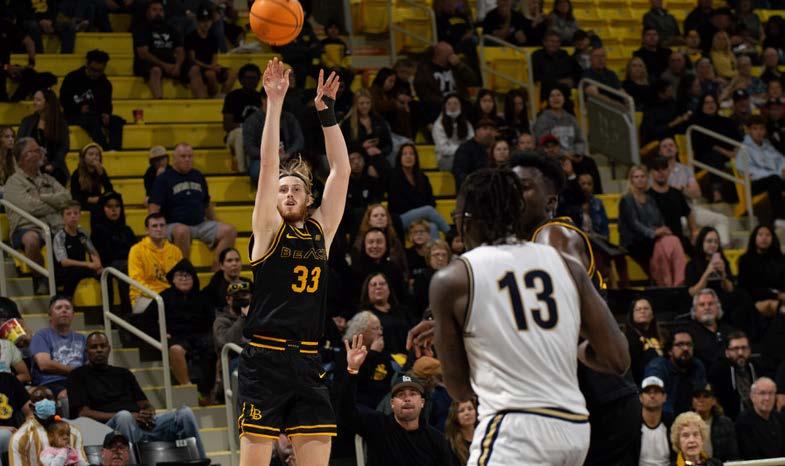
“I moved alone and stayed in dorms,” Rotegaard said.
Since coming to the U.S., Rotegaard spent time at four different programs, each in a new state, playing a different system than the last.
“It was four straight years of new coaches, so I got kind of used to it,” Rotegaard said. “But it’s nice to be able to come back this year and you know what you are coming to and how you are going to be coached.”
With the lack of solidity in coaching, Rotegaard was also adjusting to cultural differences in a country he wasn’t raised in. His mom is American and he spent summers growing up visiting relatives in Florida, Oregon and Texas.
The three states weren’t landing spots for Rotegaard when he came to the U.S., leaving him in an unfamiliar situation when he first moved to Virginia.
“Different ways to show respect here, it’s always like, ‘how are you doing, sir?’” Rotegaard said. “Where Norway’s trying to be respectful about distancing and stuff like that.”
At the international level, he represented Norway at multiple youth tournaments, with his most successful stints coming at the 2019 Nordic Championships, as well as the Under-19 Norwegian Championships where he was named MVP for both performances.
“Norway’s a small country, not really a big basketball country culture wise,” Rotegaard said. “So I always treasure those years where I get to play with them.”
This season, Rotegaard has seen his role increase at The Beach, a sign that he’s finally settling in at his new home.
Through 20 games this season, he has already played more minutes than he did in his 32 appearance last season, all while becoming a more reliable scorer and cutting his turnovers in half.
“Our seniors last year were great just taking me under their wing,” Rotegaard said. “Especially Colin Slater, he was always there for me, talking to me when I needed anything.”
was compared to his home country.
“We don’t have much fast food (in the Ivory Coast). The food was something that was completely different to me,” Traore said.
The food culture in the United States came as a huge surprise to Traore, so he gave his knowledge of the food of the Ivory Coast.
“We have garba, that’s like the main food in Africa," Traore said. "When you say Ivory Coast, and talk about food, that’s one of the main things that people will tell you."
He continued by adding that it is something that is cheap and available everywhere.
Garba consists of fried tuna pieces, chopped onions, tomatoes, peppers, cassava and semolina, topped with dashes of seasoning and cooking oil.
Traore looks to capitalize on the opportunity of playing basketball in the United States and compared it to what basketball is like in the Ivory Coast.
“Back home, you can’t live off of basketball. It’s almost impossible," Traore said. "You don’t have people who are working to help you so that you can focus on the main thing, school and basketball. The difference is really clear."
Norway’s a small country, not really a big basketball country culture wise, so I always treasure those years where I get to play with them.
Ivory Coast native Aboubacar Traore looks to make a name for himself on the Southern California coast.NAOKI GIMA / Daily Forty-Niner Aboubacar Traore brings the ball up the court during the game against Montana State back in November. Norwegian basketball forward Tobias Rotegaard has found a program to call home. NAOKI GIMA / Daily Forty-Niner Norwegian basketball player, Tobias Rotegaard, takes a three-point shot gainst Montana State in November 2022.


